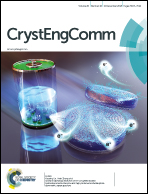Luminescence and thermal stability enhancement by matrix luminescence center dispersion in Sc(V, P)O4: Dy3+ nano/submicron phosphors†
Abstract
Sensitizers play important roles in the practical application of luminescence materials. Sensitizer ions with forbidden transitions usually exhibit smaller absorption regions and low energy transfer efficiencies, while sensitizer ions with allowed transitions tend to generate self-emissions that are too strong to achieve simple sensitization effects. To solve this problem, we propose an approach of modified matrix sensitization. When designing our novel Sc(V, P)O4: Dy3+ nano/submicron particles, we introduced a PO43− group in the host to efficiently separate the VO43− groups. Based on the premise of the large absorption region of the sensitive center, the energy loss by nonradiative transitions due to interactions of VO43− is decreased. Consequently, the strong excitation energy can be transferred to Dy3+ and improve the luminescence efficiency and thermal quenching performance of Dy3+. At the same time, the morphology and size of Sc(V, P)O4: Dy3+ can be tuned in a controlled manner by altering the P5+ content. All the properties have been studied by XRD, SEM, TEM, PL and CL in detail; the results demonstrate that these materials have potential applications in fluorescent lamps and displays.



 Please wait while we load your content...
Please wait while we load your content...